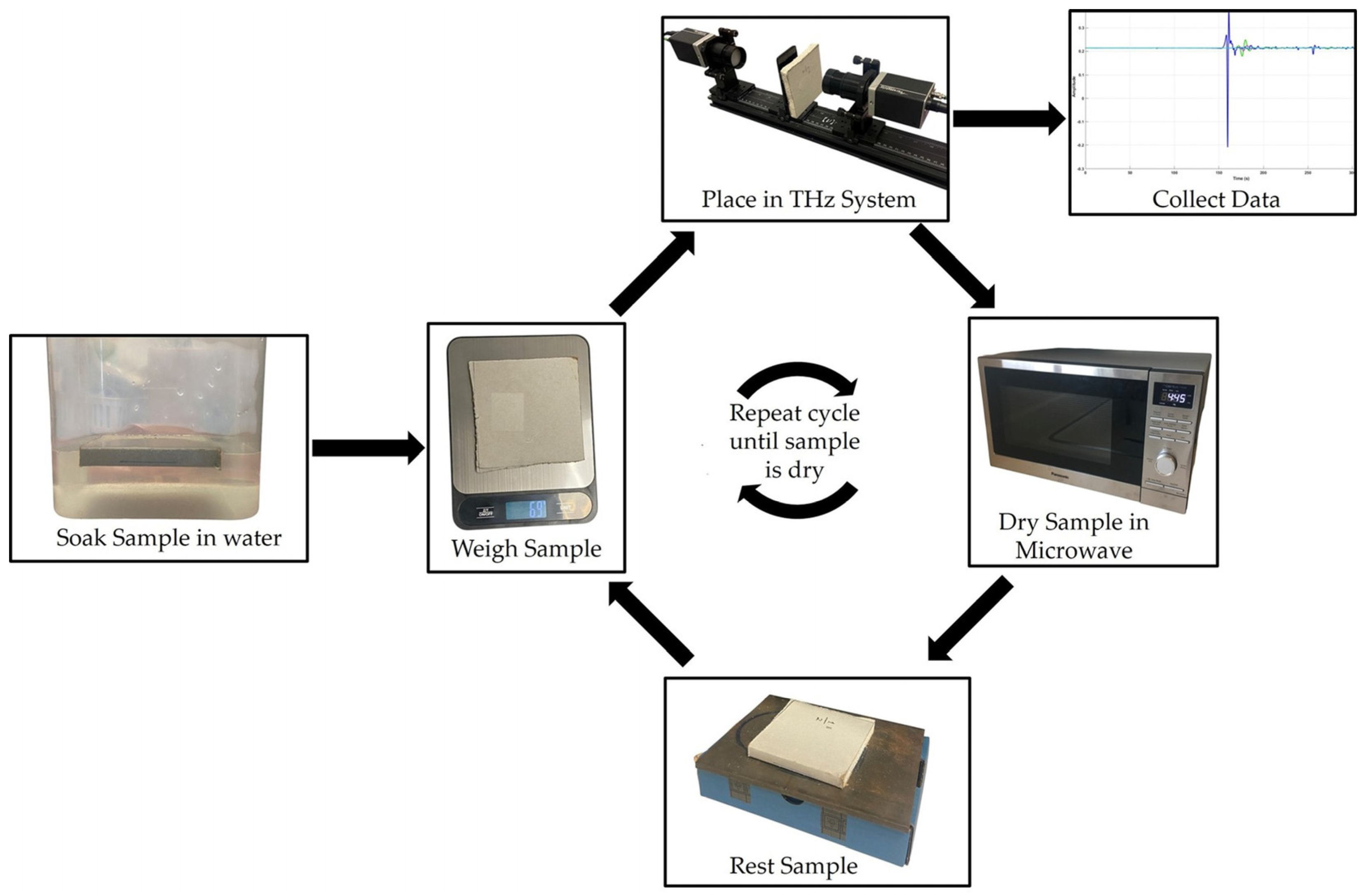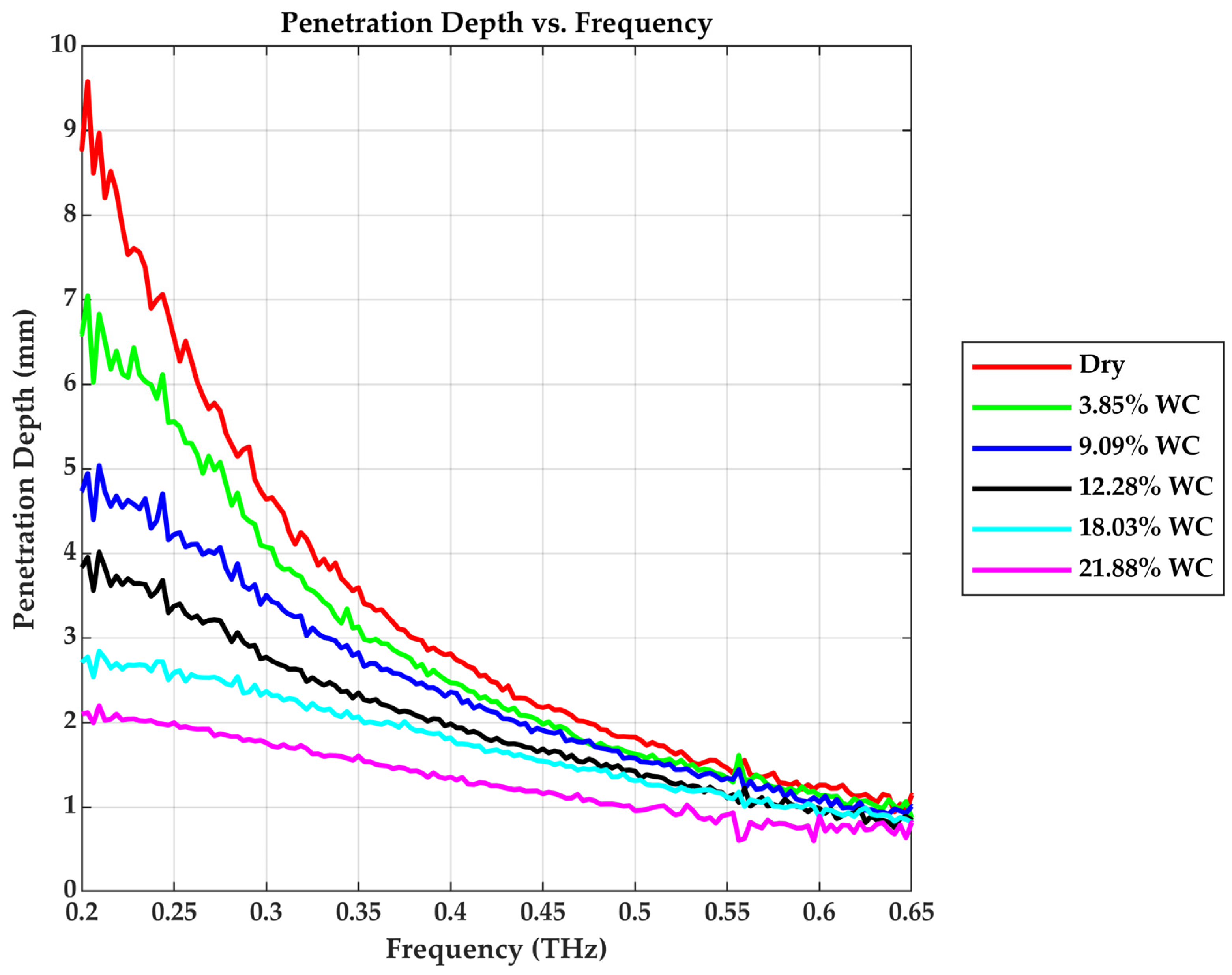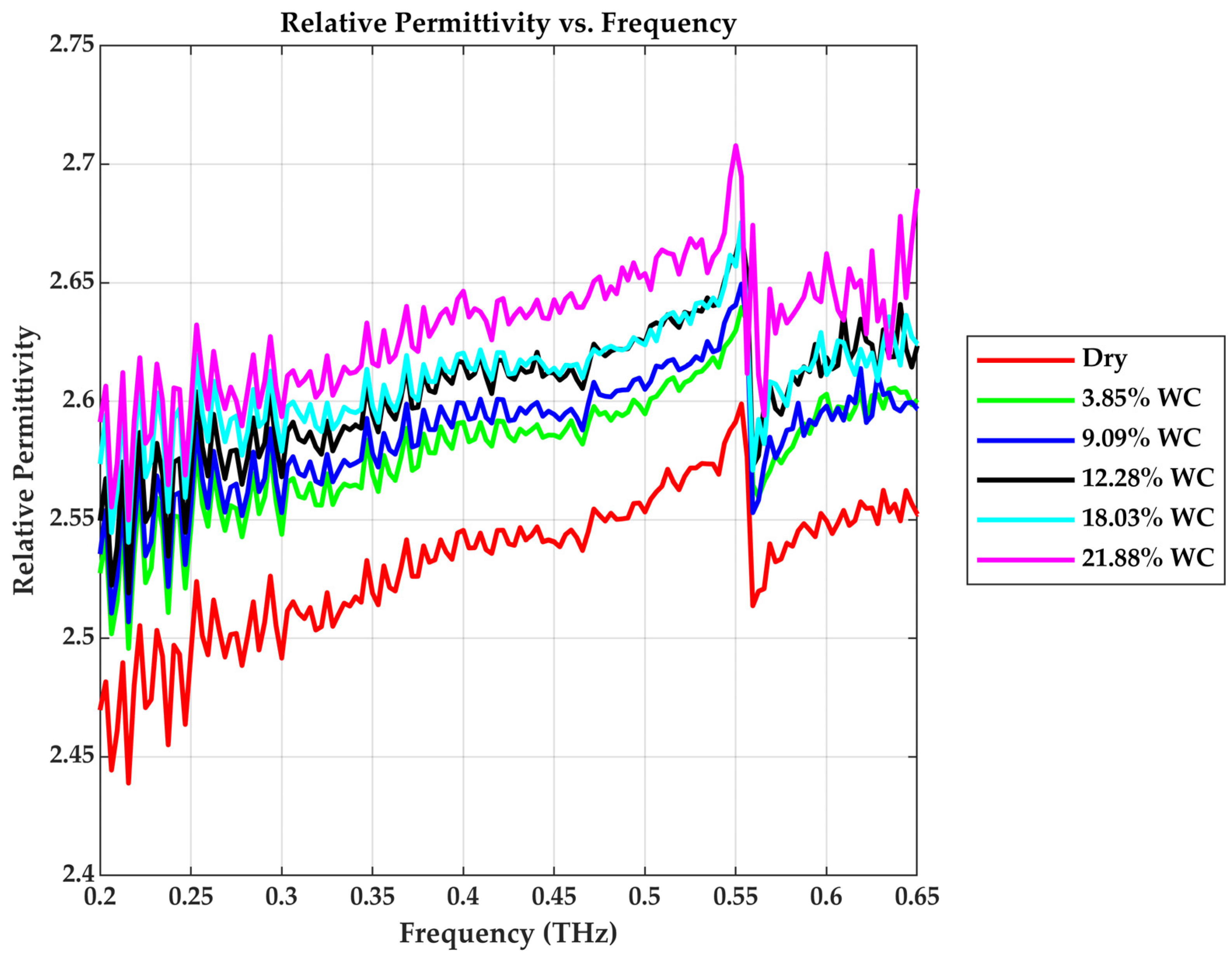Non-Destructive Characterization of Drywall Moisture Content Using Terahertz Time-Domain Spectroscopy
Abstract
1. Introduction
2. Materials and Methods
2.1. Drywall Sample Preparation and Moisture Conditioning
2.2. Terahertz Time-Domain Spectroscopy Setup
2.3. Time- and Frequency Domain Signal Comparison
2.4. Data Processing and Material Parameter Extraction
3. Results and Discussion
3.1. Refractive Index ()
3.2. Absorption Coefficient (α) and Penetration Depth (δ)
3.3. Extinction Coefficient ()
3.4. Relative Permittivity ()
3.5. Dissipation Factor (tan )
4. Conclusions
Author Contributions
Funding
Institutional Review Board Statement
Informed Consent Statement
Data Availability Statement
Acknowledgments
Conflicts of Interest
References
- Teti, A.J.; Rodriguez, D.E.; Federici, J.F.; Brisson, C. Non-Destructive Measurement of Water Diffusion in Natural Cork Enclosures Using Terahertz Spectroscopy and Imaging. J. Infrared Millim. Terahertz Waves 2011, 32, 513–527. [Google Scholar] [CrossRef]
- Chua, H.S.; Upadhya, P.C.; Haigh, A.D.; Obradovic, J.; Gibson, A.A.P.; Linfield, E.H. Terahertz Time-Domain Spectroscopy of Wheat Grain. In Proceedings of the 2004 Joint 29th International Conference on 2004 and 12th International Conference on Terahertz Electronics, Karlsruhe, Germany, 27 September–1 October 2004. [Google Scholar] [CrossRef]
- Derome, D.; Roels, S.; Carmeliet, J. Qualitative Work to Study Water Movement in Wood. 2005. Available online: https://www.researchgate.net/publication/228537797 (accessed on 29 August 2025).
- Bensalem, M.; Sommier, A.; Mindeguia, J.C.; Batsale, J.C.; Pradere, C. Terahertz Measurement of the Water Content Distribution in Wood Materials. J. Infrared Millim. Terahertz Waves 2017, 39, 195–209. [Google Scholar] [CrossRef]
- Zahid, A.; Abbas, H.T.; Imran, M.A.; Qaraqe, K.A.; Alomainy, A.; Cumming, D.R.S.; Abbasi, Q.H. Characterization and Water Content Estimation Method of Living Plant Leaves Using Terahertz Waves. Appl. Sci. 2019, 9, 2781. [Google Scholar] [CrossRef]
- Heidrich, L.; Abdelkader, A.; Ornik, J.; Castro-Camus, E.; Keck, C.M.; Koch, M. Terahertz Spectroscopy for Non-Destructive Solid-State Investigation of Norfloxacin in Paper Tablets after Wet Granulation. Pharmaceutics 2023, 15, 1786. [Google Scholar] [CrossRef] [PubMed]
- Ge, H.; Sun, Z.; Jiang, Y.; Wu, X.; Jia, Z.; Cui, G.; Zhang, Y. Recent Advances in THz Detection of Water. Int. J. Mol. Sci. 2023, 24, 10936. [Google Scholar] [CrossRef] [PubMed]
- Born, N.; Gente, R.; Behringer, D.; Schwerdtfeger, M.; Busch, S.; Liepelt, S.; Ziegenhagen, B.; Koch, M. Monitoring the water status of plants using THz radiation. In Proceedings of the 2014 39th International Conference on Infrared, Millimeter, and Terahertz waves (IRMMW-THz), Tucson, AZ, USA, 14–19 September 2014; pp. 1–2. [Google Scholar]
- Gong, Z.; Deng, D.; Sun, X.; Liu, J.; Ouyang, Y. Non-destructive detection of moisture content for Ginkgo biloba fruit with terahertz spectrum and image: A preliminary study. Infrared Phys. Technol. 2022, 120, 103997. [Google Scholar] [CrossRef]
- Lee, G.-J.; Kim, S.; Kwon, T.-H. Effect of Moisture Content and Particle Size on Extinction Coefficients of Soils Using Terahertz Time-Domain Spectroscopy. IEEE Trans. Terahertz Sci. Technol. 2017, 7, 529–535. [Google Scholar] [CrossRef]
- Yu, M.; Yan, J.; Chu, J.; Qi, H.; Xu, P.; Liu, S.; Zhou, L.; Gao, J. Accurate prediction of wood moisture content using terahertz time-domain spectroscopy combined with machine learning algorithms. Ind. Crop. Prod. 2025, 227, 120771. [Google Scholar] [CrossRef]
- Hoła, A. Verification of Non-Destructive Assessment of Moisture Content of Historical Brick Walls Using Random Forest Algorithm. Appl. Sci. 2023, 13, 6006. [Google Scholar] [CrossRef]
- Norgaard, J.; Mydin, M.A.O. Drywall Thermal Properties Exposed toHigh Temperatures andFire Condition. J. Teknol. (Sci. Eng.) 2013, 62. [Google Scholar] [CrossRef]
- Olszewska-Pastuszak, D.; Suchorab, Z.; Tabiś, K.; Pluta, K. Application of Karl Fischer titration method to determine moisture content of building materials. Measurement 2025, 256, 118363. [Google Scholar] [CrossRef]
- Dafico, L.C.M.; Barreira, E.; Almeida, R.M.S.F.; Carasek, H. Comparison of Infrared Thermography and Other Traditional Techniques to Assess Moisture Content of Wall Specimens. Sensors 2022, 22, 3182. [Google Scholar] [CrossRef] [PubMed]
- Zambrano, M.V.; Dutta, B.; Mercer, D.G.; MacLean, H.L.; Touchie, M.F. Assessment of moisture content measurement methods of dried food products in small-scale operations in developing countries: A review. Trends Food Sci. Technol. 2019, 88, 484–496. [Google Scholar] [CrossRef]
- Nagaraj, P. Propagation Characteristics of Millimeter Wave and Terahertz Frequencies in 6G & Beyond Systems. 2023. Available online: https://www.researchgate.net/publication/376170940_Propagation_Characteristics_of_Millimeter_Wave_and_Terahertz_Frequencies_in_6G_Beyond_Systems (accessed on 29 August 2025).
- Rappaport, T.S.; Xing, Y.; Kanhere, O.; Ju, S.; Madanayake, A.; Mandal, S.; Alkhateeb, A.; Trichopoulos, G.C. Wireless Communications and Applications Above 100 GHz: Opportunities and Challenges for 6G and Beyond. IEEE Access 2019, 7, 78729–78757. [Google Scholar] [CrossRef]
- T-Ray® 5000 System Overview. Available online: https://lunainc.com/sites/default/files/assets/files/resource-library/TRay5000_System_OverviewTCU-Sensors-1-Sheet-v4-FINAL.pdf (accessed on 29 August 2025).
- T-Ray ® Server Software Overview T-RAY ® 5000 SERIES. Available online: https://www.lunainc.com/t-ray-server-software-data-sheet (accessed on 29 August 2025).
- Kashima, M.; Tsuchikawa, S.; Inagaki, T. Simultaneous detection of density, moisture content and fiber direction of wood by THz time-domain spectroscopy. J. Wood Sci. 2020, 66, 27. [Google Scholar] [CrossRef]
- Fishman, D. THz Time-Domain Spectroscopy for Dummies. 2019. Available online: https://www.chem.uci.edu/~dmitryf/manuals/Fundamentals/Thor.pdf (accessed on 29 August 2025).
- Jepsen, P.U. Phase Retrieval in Terahertz Time-Domain Measurements: A “how to” Tutorial. J. Infrared Millim. Terahertz Waves 2019, 40, 395–411. [Google Scholar] [CrossRef]
- Jepsen, P.; Cooke, D.; Koch, M. Terahertz spectroscopy and imaging—Modern techniques and applications. Laser Photonics Rev. 2012, 6, 418. [Google Scholar] [CrossRef]
- Cui, H.; Zhang, X.; Su, J.; Yang, Y.; Fang, Q.; Wei, X. Vibration–rotation absorption spectrum of water vapor molecular in frequency selector at 0.5–2.5 THz range. Optik 2015, 126, 3533–3537. [Google Scholar] [CrossRef]
- Novelli, F.; Guchhait, B.; Havenith, M. Towards Intense THz Spectroscopy on Water: Characterization of Optical Rectification by GaP, OH1, and DSTMS at OPA Wavelengths. Materials 2020, 13, 1311. [Google Scholar] [CrossRef] [PubMed]
- Tanabe, T.; Kanai, T.; Kuroo, K.; Nishiwaki, T.; Oyama, Y. Non-Contact Terahertz Inspection of Water Content in Concrete of Infrastructure Buildings. World J. Eng. Technol. 2018, 6, 275–281. [Google Scholar] [CrossRef]










| Water Content (%) | Penetration Depth (mm) | |||||
|---|---|---|---|---|---|---|
| 0 | 1.595 | 355.4 | 0.00037 | 2.54 | 0.00046 | 2.81 |
| 3.85 | 1.609 | 404.5 | 0.00042 | 2.59 | 0.00052 | 2.47 |
| 9.09 | 1.612 | 423.2 | 0.00044 | 2.60 | 0.00054 | 2.36 |
| 12.28 | 1.618 | 503.6 | 0.00052 | 2.61 | 0.00065 | 1.99 |
| 18.03 | 1.619 | 550.5 | 0.00057 | 2.62 | 0.00071 | 1.82 |
| 21.88 | 1.627 | 738.4 | 0.00077 | 2.65 | 0.00095 | 1.35 |
Disclaimer/Publisher’s Note: The statements, opinions and data contained in all publications are solely those of the individual author(s) and contributor(s) and not of MDPI and/or the editor(s). MDPI and/or the editor(s) disclaim responsibility for any injury to people or property resulting from any ideas, methods, instructions or products referred to in the content. |
© 2025 by the authors. Licensee MDPI, Basel, Switzerland. This article is an open access article distributed under the terms and conditions of the Creative Commons Attribution (CC BY) license (https://creativecommons.org/licenses/by/4.0/).
Share and Cite
Adeagbo, H.F.; Yang, B. Non-Destructive Characterization of Drywall Moisture Content Using Terahertz Time-Domain Spectroscopy. Sensors 2025, 25, 5576. https://doi.org/10.3390/s25175576
Adeagbo HF, Yang B. Non-Destructive Characterization of Drywall Moisture Content Using Terahertz Time-Domain Spectroscopy. Sensors. 2025; 25(17):5576. https://doi.org/10.3390/s25175576
Chicago/Turabian StyleAdeagbo, Habeeb Foluso, and Binbin Yang. 2025. "Non-Destructive Characterization of Drywall Moisture Content Using Terahertz Time-Domain Spectroscopy" Sensors 25, no. 17: 5576. https://doi.org/10.3390/s25175576
APA StyleAdeagbo, H. F., & Yang, B. (2025). Non-Destructive Characterization of Drywall Moisture Content Using Terahertz Time-Domain Spectroscopy. Sensors, 25(17), 5576. https://doi.org/10.3390/s25175576







